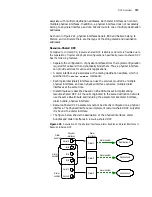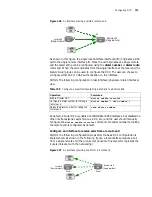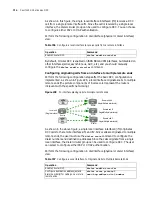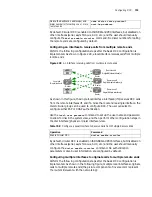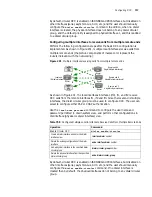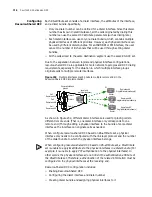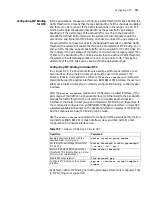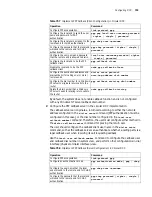
708
C
HAPTER
51: C
ONFIGURING
DCC
As shown in Figure 225, a physical interface can belong to multiple dialer bundles
and hence serve multiple dialer interfaces, but each dialer interface associates with
only one destination address. Each dialer interface can use only one dialer bundle
that contains multiple physical interfaces having different priorities.
In Figure 225, Dialer2 uses Dialer bundle2, and physical interfaces Bri0, Bri1 and
Bri2 are members of Dialer bundle2. These physical interfaces have different
priorities. Suppose that Bri0 in Dialer bundle2 is assigned with the priority 100,
Bri1 with 50, and Bri2 with 75. Since the priority of Bri0 is higher than that of Bri1
and Bri2, Bri0 will be selected first when Dialer2 selects a physical interface from
Dialer bundle2.
DCC Features Available
with 3Com Routers
3Com routers provide flexible and practical dial interface solutions, as described in
the following sections.
Basic DCC features
Basic DCC features include support for:
■
Multiple dial interfaces, such as synchronous/asynchronous serial interface,
AUX port, ISDN BRI or PRI interface, and AM interface. The user can flexibly
combine them, depending on the actual networking and network topology.
■
Link layer protocols, such as PPP and Frame Relay, on dial interfaces (physical or
dialer interfaces)
■
Network layer protocols, such as IP, IPX and Bridge on dial interfaces.
■
Dynamic routing protocols, such as RIP and OSPF, on dial interfaces.
■
Flexible dial interface standby modes
■
Modem control on asynchronous dial interfaces for managing various modems.
Implementing callback through DCC
In callback, the “called party” originates a return call to the “calling party”. In this
case, the calling party is the client, and the called party is the server. The callback
client originates a call first, and the callback server determines whether to
originate a return call. If a callback is needed, the server immediately disconnects
and originates a return call.
DCC callback can bring the following advantages:
■
Enhances security: When placing a return call, the server dials the calling
number configured at the local end. Hence, the insecurity resulted from the
distribution of user name and password can be avoided.
■
Changes the charge bearer. This is useful for saving cost if the call rates in two
directions are different.
■
Consolidates the call charge bills, which facilitates the settlement.
3Com routers provide the PPP callback and ISDN caller identification callback
features. The PPP callback conforms to and can be adopted to a RFC1570 system
regardless of whether the client and server own fixed network addresses, or that
the client accepts the network address that is dynamically assigned.
Summary of Contents for 3036
Page 1: ...http www 3com com 3Com Router Configuration Guide Published March 2004 Part No 10014299 ...
Page 4: ...VPN 615 RELIABILITY 665 QOS 681 DIAL UP 721 ...
Page 6: ...2 ABOUT THIS GUIDE ...
Page 7: ...I GETTING STARTED Chapter 1 3Com Router Introduction Chapter 2 3Com Router User Interface ...
Page 8: ...4 ...
Page 16: ...12 CHAPTER 1 3COM ROUTER INTRODUCTION ...
Page 34: ...30 ...
Page 60: ...56 CHAPTER 3 SYSTEM MANAGEMENT ...
Page 98: ...94 CHAPTER 6 DISPLAY AND DEBUGGING TOOLS ...
Page 110: ...106 ...
Page 114: ...110 CHAPTER 8 INTERFACE CONFIGURATION OVERVIEW ...
Page 158: ...154 CHAPTER 10 CONFIGURING WAN INTERFACE ...
Page 168: ...164 ...
Page 188: ...184 CHAPTER 13 CONFIGURING PPPOE CLIENT ...
Page 192: ...188 CHAPTER 14 CONFIGURING SLIP Router ip route static 0 0 0 0 0 0 0 0 10 110 0 1 ...
Page 248: ...244 CHAPTER 16 CONFIGURING LAPB AND X 25 ...
Page 320: ...316 ...
Page 330: ...326 CHAPTER 20 CONFIGURING IP ADDRESS ...
Page 362: ...358 CHAPTER 21 CONFIGURING IP APPLICATION ...
Page 374: ...370 CHAPTER 23 CONFIGURING IP COUNT ...
Page 406: ...402 CHAPTER 25 CONFIGURING DLSW ...
Page 408: ...404 ...
Page 452: ...448 CHAPTER 29 CONFIGURING OSPF ...
Page 482: ...478 CHAPTER 30 CONFIGURING BGP ...
Page 494: ...490 CHAPTER 31 CONFIGURING IP ROUTING POLICY ...
Page 502: ...498 ...
Page 508: ...504 CHAPTER 33 IP MULTICAST ...
Page 514: ...510 CHAPTER 34 CONFIGURING IGMP ...
Page 526: ...522 CHAPTER 36 CONFIGURING PIM SM ...
Page 528: ...524 ...
Page 532: ...528 CHAPTER 37 CONFIGURING TERMINAL ACCESS SECURITY ...
Page 550: ...546 CHAPTER 38 CONFIGURING AAA AND RADIUS PROTOCOL ...
Page 590: ...586 CHAPTER 40 CONFIGURING IPSEC ...
Page 599: ...IX VPN Chapter 42 Configuring VPN Chapter 43 Configuring L2TP Chapter 44 Configuring GRE ...
Page 600: ...596 ...
Page 638: ...634 CHAPTER 43 CONFIGURING L2TP ...
Page 649: ...X RELIABILITY Chapter 45 Configuring a Standby Center Chapter 46 Configuring VRRP ...
Page 650: ...646 ...
Page 666: ...662 ...
Page 670: ...666 CHAPTER 47 QOS OVERVIEW ...
Page 700: ...696 CHAPTER 49 CONGESTION MANAGEMENT ...
Page 706: ...702 CHAPTER 50 CONGESTION AVOIDANCE ...
Page 707: ...XII DIAL UP Chapter 51 Configuring DCC Chapter 52 Configuring Modem ...
Page 708: ...704 ...
Page 762: ...758 CHAPTER 52 CONFIGURING MODEM ...














